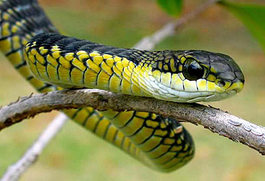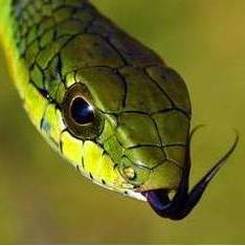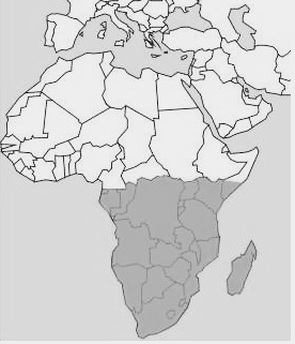BoomslangDispholidus typus |

Custom Search
|
|
The Boomslang (Dispholidus typus) is an extremely dangerous, venomous snake species found in sub-Saharan Africa in the central and southern regions of the continent. The boomslang is most abundant in Botswana, Swaziland, Namibia, Mozambique, and Zimbabwe, but the species has been reported as far north as southern Chad and Nigeria, and as far east as eastern Guinea.
They are found in a variety of ecosystems but most commonly inhabit wooded grasslands, arid savannas, karoo scrubs, and lowland forests, as they prefer areas with trees. They usually avoid extremely dry and desert-like areas. Its name, boomslang, literally means "tree snake" in Afrikaans and Dutch. The boomslang is part of the family Colubridae and although in the past several species and subspecies have been described it's currently the only species in its genus. The Boomslang is a diurnal and almost exclusively arboreal snake, it is extremely agile and capable of climbing trees and gliding through the tree branches when hunting. During the colder weather, they will brumate (a behavior similar to hibernation) for moderate periods inside the enclosed bird's nests. Most people think of the Boomslang as a bright green snake, this is not always the case. The boomslangs have different colorations depending on several factors, such as sex, age, and basic color phase differences.

The adult females are typically olive-brown in color, while the adult male snakes can be bright green, brownish black or bluish green.
Their coloring helps to camouflage these snakes in their arboreal habitats. Adult boomslangs will average between 4 and 6,5 feet (1,2 to 2 m) in length and weigh anywhere from 175 g to 510 g. Female hatchlings are a pale brown and male hatchlings are gray with blue speckles, they only reach their adult colors after several years. But one of the most distinguishing features of the boomslang species is their large eyes and egg-like shaped head. In fact, they have one of the largest eyes in relation to the head size of any snake species. The Boomslang has also an excellent eyesight. The boomslang is preyed upon by some of the larger carnivorous birds found in southern Africa like the secretary birds, falcons, kestrels, ospreys, and diurnal raptors.They have an average lifespan of around 8 years in the wild. The Boomslang is also featured in pop culture, for instance it's shredded skin is used in Harry Potter and the Chamber of Secrets to make the Polyjuice Potion. Its deadly venom is used as a murder weapon in Agatha Christie's Death in the Clouds and an in an episode of Quincy, M.E., and Boomslang is also the name of Marvel Comics supervillain character. Venom / Bite The boomslang is one of the few venomous snakes of the Colubridae family since most colubrid snakes are non-venomous. However, the boomslang has a powerful haemotoxic venom that it injects with its small 3 to 5 mm long rear fangs, located beneath the eyes. Since they have rear fangs boomslangs are capable of opening their jaws up to 170 degrees when biting. They are capable of folding their fangs back into their mouth when not in use. Because of their particular anatomy, not very well suited to bite humans, the boomslang was regarded as harmless until 26th of September 1957. When Karl P. Schmidt an eminent herpetologist from Chicago's Lincoln Park Zoo was found dead 24 hours after a juvenile boomslang bit him in his thumb. Since he believed the small snake couldn't inject a lethal dose of venom, he didn’t seek immediate medical treatment. He died the next day from severe brain hemorrhaging and respiratory arrest (see video below). Schmidt recorded all the symptoms as they arrived, in a diary that covered the 15 hour period prior to his demise, around breakfast next morning. After this unfortunate incident subsequent studies found just how toxic the boomslang venom was. Schmidt's death forever altered our perception of the boomslang and nowadays they rank as one of Africa's most venomous snakes. But the reality is that since Schmidt's death there were only 7 more deaths caused by boomslangs. Its venom affects the human body blood clotting mechanism, resulting in headaches, nausea, sleepiness. If left untreated the victim may die as a result of internal and external bleeding.
Although powerful the venom is slow acting and the symptoms may not be apparent until many hours after the bite. Venomous snakes may sometimes fail to inject venom when they bite so a victim of a boomslang bite may wrongly believe that the injury is not serious. It is also one of the only colubrids capable of killing a human, with its venomous bite. Although such cases of human fatalities are rare since they are a very timid species. Most bites occur when people attempt to handle, catch or kill the animal, if confronted and cornered, the snake inflates the neck and assumes an "S" shape pose ready to strike. Diet / Feeding The Boomslang eats birds and nestlings, lizards, chameleons, insects or any small enough prey that they can swallow, they will occasionally kill and eat other snakes including their own species. Despite the fact of being mainly arboreal snake they will come to the ground and even cross water and roads to hunt for prey. Reproduction The boomslang breeding season occurs from July to early October. Sometimes males become more aggressive, resulting in occasional ritualistic combats with other males, for the right to mate females in the area. The Boomslang is oviparous, and it produces up to 30 eggs per clutch, which are laid in hollow tree trunks or rotting logs. The eggs have an incubation period relatively long, around 3 months on average. The sex of the boomslang offspring is dependent on incubation temperatures, just like crocodiles. The hatchlings are approximately 20 cm in length and pose little or no threat to humans, but become dangerously venomous by the time they reach a length of about 45 cm. They shed their first skin within 10 days of birth. Conservation / Threats The Boomslang is listed by the IUCN Red List as least concern species, and the boomslang isn't at risk of becoming endangered or threatened in the near future. The species isn't listed in CITES.
|
Did You Know?
The hibernation period for snakes is called brumation, find more cool snake facts for kids. Scientific classification |
© 2014 Snake Facts About Us | Privacy Policy | Contact




